-
-
Save tetsuok/2280162 to your computer and use it in GitHub Desktop.
| package main | |
| import "code.google.com/p/go-tour/pic" | |
| func Pic(dx, dy int) [][]uint8 { | |
| // Allocate two-dimensioanl array. | |
| a := make([][]uint8, dy) | |
| for i := 0; i < dy; i++ { | |
| a[i] = make([]uint8, dx) | |
| } | |
| // Do something. | |
| for i := 0; i < dy; i++ { | |
| for j := 0; j < dx; j++ { | |
| switch { | |
| case j % 15 == 0: | |
| a[i][j] = 240 | |
| case j % 3 == 0: | |
| a[i][j] = 120 | |
| case j % 5 == 0: | |
| a[i][j] = 150 | |
| default: | |
| a[i][j] = 100 | |
| } | |
| } | |
| } | |
| return a | |
| } | |
| func main() { | |
| pic.Show(Pic) | |
| } |
//Magnetic Field (properly, Magnetic Induction) around straight conductors, with currents flowing in opposite directions.
package main
import (
"math"
//"fmt"
"golang.org/x/tour/pic"
)
func Pic(dx, dy int) (out [][]uint8) {
for i := 0; i < dy; i++ {
row := make([]uint8, dx)
for j := range row {
row[j] = uint8(Bfield(float64(i), float64(j)))
}
out = append(out, row)
}
return out
}
func Bfield(xp, yp float64) (Bvalue float64) {
const mu0 = 4e-7 * math.Pi //Vacuum permeability
const mu = 0.5 * mu0 / math.Pi //Multiplicative Factor
const I1, I2 = 8e4, -8e4 //current in conductors 1 & 2
const X1, Y1 = 128, 192 //abscissa, ordinate of conductor1
const X2, Y2 = 128, 64 //abscissa, ordinate of conductor2
Bxvalue1 := mu * I1 * (Y1 - yp) / (math.Pow(X1-xp, 2) + math.Pow(Y1-yp, 2))
Byvalue1 := mu * I1 * (xp - X1) / (math.Pow(X1-xp, 2) + math.Pow(Y1-yp, 2))
Bxvalue2 := mu * I2 * (Y2 - yp) / (math.Pow(X2-xp, 2) + math.Pow(Y2-yp, 2))
Byvalue2 := mu * I2 * (xp - X2) / (math.Pow(X2-xp, 2) + math.Pow(Y2-yp, 2))
Bvalue = (1e6 * (math.Pow(math.Pow(Bxvalue1+Bxvalue2, 2)+math.Pow(Byvalue1+Byvalue2, 2), 0.5)))
return Bvalue
}
func main() {
pic.Show(Pic)
}
package main
import (
"golang.org/x/tour/pic"
)
func Pic(dx, dy int) [][]uint8 {
picture := make([][]uint8, dy)
for i := range picture {
picture[i] = make([]uint8, dx)
}
for i := 0; i < dy; i++ {
for j := 0; j < dx; j++ {
picture[i][j] = uint8((i^j) - (i+j))
}
}
return picture
}
func main() {
pic.Show(Pic)
}
package main
import (
"golang.org/x/tour/pic"
)
func Pic(dx, dy int) [][]uint8 {
res := make([][]uint8, dy)
for i := 0; i < dy; i++ {
res[i] = make([]uint8, dx)
for j := range res[i] {
res[i][j] = uint8((i * j * i * j / 2) * (j * i * j * i / 2))
}
}
return res
}
func main() {
pic.Show(Pic)
}package main
import "golang.org/x/tour/pic"
func Pic(dx, dy int) (picture [][]uint8) {
picture = make([][]uint8, dy)
for y := range picture {
picture[y] = make([]uint8, dx)
for x := range picture[y] {
if y % 2 == 1 {
picture[y][x] = uint8((y+x*2)^(y-x*2))
} else {
picture[y][x] = uint8((x+y*2)^(x-y*2))
}
}
}
return picture
}
func main() {
pic.Show(Pic)
}package main
import "golang.org/x/tour/pic"
func Pic(dx, dy int) [][]uint8 {
s := make([][]uint8, dy)
for y := range s {
s[y] = make([]uint8, dx)
for x := range s[y] {
s[y][x] = interpretCoordinate(x,y)
}
}
return s
}
func interpretCoordinate(x, y int) uint8 {
n := x^y
return uint8(n)
}
func main() {
pic.Show(Pic)
}package main
import "math"
import "golang.org/x/tour/pic"
func Pic(dx, dy int) [][]uint8 {
s := make([][]uint8, dy)
for y := range s {
s[y] = make([]uint8, dx)
for x := range s[y] {
s[y][x] = gopher(x, y)
}
}
return s
}
func gopher(x, y int) uint8 {
xx := float64(x)
yy := float64(y)
params := [][6]float64 {
{180, 50, 3, 3, 0, 255},
{175, 50, 10, 10, 0, 0},
{105, 80, 3, 3, 0, 255},
{100, 80, 10, 10, 0, 0},
{155, 55, 30, 30, 0, 255},
{155, 55, 32, 32, 0, 0},
{80, 85, 30, 30, 0, 255},
{80, 85, 32, 32, 0, 0},
{130, 90, 7, 1, 24, 255},
{125, 95, 13, 8, 24, 0},
{133, 128, 12, 5, 114, 255},
{133, 128, 13, 6, 114, 0},
{143, 124, 12, 5, 116, 255},
{143, 124, 13, 6, 116, 0},
{130, 108, 22, 12, 23, 160},
{130, 108, 24, 14, 23, 0},
{183, 178, 14, 8, -20, 255},
{183, 178, 15, 9, -20, 0},
{131, 108, 96, 100, 0, 220},
{151, 158, 90, 100, 0, 220},
{151, 188, 90, 100, 0, 220},
{243, 148, 14, 8, -20, 255},
{243, 148, 15, 9, -20, 0},
{205, 36, 2, 2, 0, 255},
{203, 42, 10, 10, 0, 0},
{206, 44, 21, 21, 0, 255},
{206, 44, 23, 23, 0, 0},
{33, 102, 10, 10, 0, 0},
{36, 104, 21, 21, 0, 255},
{36, 104, 23, 23, 0, 0},
}
for _, p := range params {
if judge(xx, yy, p[0], p[1], p[2], p[3], p[4]) {
return uint8(p[5])
}
}
return 255
}
func judge(x, y, cx, cy, a, b, deg float64) bool {
t := deg * math.Pi / 180
ct := math.Cos(t)
st := math.Sin(t)
x2 := (x - cx)
y2 := (y - cy)
x3 := (ct * x2 - st * y2) / a
y3 := (st * x2 + ct * y2) / b
return x3 * x3 + y3 * y3 < 1
}
func main() {
pic.Show(Pic)
}package main
import "golang.org/x/tour/pic"
func Pic(dx, dy int) [][]uint8 {
pictureArray := make([][]uint8, dy)
for i := range pictureArray {
pictureArray[i] = make([]uint8, dx)
for j := range pictureArray[i] {
pictureArray[i][j] = uint8((i * j / 4) + (i ^ j + 1))
}
}
return pictureArray
}
func main() {
pic.Show(Pic)
}
package main import "math" import "golang.org/x/tour/pic" func Pic(dx, dy int) [][]uint8 { s := make([][]uint8, dy) for y := range s { s[y] = make([]uint8, dx) for x := range s[y] { s[y][x] = gopher(x, y) } } return s } func gopher(x, y int) uint8 { xx := float64(x) yy := float64(y) params := [][6]float64 { {180, 50, 3, 3, 0, 255}, {175, 50, 10, 10, 0, 0}, {105, 80, 3, 3, 0, 255}, {100, 80, 10, 10, 0, 0}, {155, 55, 30, 30, 0, 255}, {155, 55, 32, 32, 0, 0}, {80, 85, 30, 30, 0, 255}, {80, 85, 32, 32, 0, 0}, {130, 90, 7, 1, 24, 255}, {125, 95, 13, 8, 24, 0}, {133, 128, 12, 5, 114, 255}, {133, 128, 13, 6, 114, 0}, {143, 124, 12, 5, 116, 255}, {143, 124, 13, 6, 116, 0}, {130, 108, 22, 12, 23, 160}, {130, 108, 24, 14, 23, 0}, {183, 178, 14, 8, -20, 255}, {183, 178, 15, 9, -20, 0}, {131, 108, 96, 100, 0, 220}, {151, 158, 90, 100, 0, 220}, {151, 188, 90, 100, 0, 220}, {243, 148, 14, 8, -20, 255}, {243, 148, 15, 9, -20, 0}, {205, 36, 2, 2, 0, 255}, {203, 42, 10, 10, 0, 0}, {206, 44, 21, 21, 0, 255}, {206, 44, 23, 23, 0, 0}, {33, 102, 10, 10, 0, 0}, {36, 104, 21, 21, 0, 255}, {36, 104, 23, 23, 0, 0}, } for _, p := range params { if judge(xx, yy, p[0], p[1], p[2], p[3], p[4]) { return uint8(p[5]) } } return 255 } func judge(x, y, cx, cy, a, b, deg float64) bool { t := deg * math.Pi / 180 ct := math.Cos(t) st := math.Sin(t) x2 := (x - cx) y2 := (y - cy) x3 := (ct * x2 - st * y2) / a y3 := (st * x2 + ct * y2) / b return x3 * x3 + y3 * y3 < 1 } func main() { pic.Show(Pic) }
this is amazing!
package main
import "golang.org/x/tour/pic"
func Pic(dx, dy int) [][]uint8 {
img := make([][]uint8, dy)
for y := range img {
img[y] = make([]uint8, dx)
for x := range img[y] {
i := uint8(y)
j := uint8(x)
value := (i + j)
if value < 125{
img[i][j] = j * j
} else{
img[i][j] = i * i
}
}
}
return img
}
func main() {
pic.Show(Pic)
}
Mandelbrot set
package main
import (
"golang.org/x/tour/pic"
)
const (
maxIter uint8 = 100
brightness uint8 = 20
min complex128 = -2 + 1.4i
max complex128 = 0.8 - 1.4i
)
func Pic(dx, dy int) [][]uint8 {
picture := make([][]uint8, dy)
for i := range picture {
picture[i] = make([]uint8, dx)
}
rMin := real(min)
iMin := imag(max)
sX := (real(max) - real(min)) / float64(dx-1)
sY := (imag(min) - imag(max)) / float64(dy-1)
for y := 0; y < dy; y++ {
for x := 0; x < dx; x++ {
realPart := float64(x)*sX + rMin
imagPart := float64(y)*sY + iMin
picture[y][x] = Mandelbrot(complex(realPart, imagPart)) * brightness
}
}
return picture
}
func Mandelbrot(c complex128) uint8 {
z := c
for it := uint8(0); it < maxIter; it++ {
z = z*z + c
if r, i := real(z), imag(z); r*r+i*i > 4 {
return it
}
}
return maxIter
}
func main() {
pic.Show(Pic)
}
package main
import (
"image"
"github.com/Max95Cohen/gopher"
"golang.org/x/tour/pic"
)
func Pic(dx, dy int) [][]uint8 {
var a = make([][]uint8, dy)
for i := 0; i < dy; i++ {
a[i] = make([]uint8, dx)
}
for i := 0; i < dy; i++ {
for j := 0; j < dx; j++ {
a[i][j] = 255
}
}
var p = &a
return gopher.GetPixels(*p)
}
func show(f func(dx, dy int) [][]uint8) {
const (
dx = 256
dy = 256
)
data := f(dx, dy)
m := image.NewNRGBA(image.Rect(0, 0, dx, dy))
for y := 0; y < dy; y++ {
for x := 0; x < dx; x++ {
v := data[y][x]
i := y*m.Stride + x*4
var r, g, b uint8
if v == 255 {
r = 255
g = 0
b = 255
} else {
r = 0
g = 255
b = 0
}
m.Pix[i] = r
m.Pix[i+1] = g
m.Pix[i+2] = b
m.Pix[i+3] = 255
}
}
pic.ShowImage(m)
}
func main() {
show(Pic)
}Very suspicious pattern
package main
import "golang.org/x/tour/pic"
const (
VAL_MAX uint8 = 255
AMOG_DX uint8 = 10
AMOG_DY uint8 = 10
)
// ඞ
var AMOGUS = [AMOG_DY][AMOG_DX]uint8{
{0, 0, 0, 0, 0, 0, 0, 0, 0, 0},
{0, 0, 0, 0, 0, 0, 0, 0, 0, 0},
{0, 0, 0, 0, 2, 2, 2, 0, 0, 0},
{0, 0, 0, 2, 2, 1, 1, 1, 0, 0},
{0, 0, 2, 2, 2, 2, 2, 2, 0, 0},
{0, 0, 2, 2, 2, 2, 2, 2, 0, 0},
{0, 0, 0, 2, 2, 2, 2, 2, 0, 0},
{0, 0, 0, 2, 0, 0, 0, 2, 0, 0},
{0, 0, 0, 0, 0, 0, 0, 0, 0, 0},
{0, 0, 0, 0, 0, 0, 0, 0, 0, 0},
}
func Shader(x, y int) uint8 {
x_u := uint8(x) % AMOG_DX
y_u := uint8(y) % AMOG_DY
return AMOGUS[y_u][x_u]*(VAL_MAX>>1) + 1
}
func Pic(dx, dy int) [][]uint8 {
buf := make([][]uint8, dy)
for y := range buf {
column := make([]uint8, dx)
for x := range column {
column[x] = Shader(x, y)
}
buf[y] = column
}
return buf
}
func main() {
pic.Show(Pic)
}package main
import "golang.org/x/tour/pic"
// import "fmt"
func pointValue1(x, y int) uint8 {
return uint8((x + y) / 2)
}
func pointValue2(x, y int) uint8 {
return uint8(x * y)
}
func pointValue3(x, y int) uint8 {
return uint8(x ^ y)
}
func Pic(dx, dy int) [][]uint8 {
// initialize slice rows with dy length
var matrix [][]uint8
// initialize the i'th element of rows with dx length slice
for i := 0; i < dy; i ++ {
// var array_rows [dx]uint8
var array_rows []uint8
// update the value of each point
for j := 0; j < dx; j ++ {
// array_rows[j] = pointValue1(i, j)
array_rows = append(array_rows, pointValue3(i, j))
}
// matrix = append(matrix, array_rows[0:])
matrix = append(matrix, array_rows)
}
// fmt.Println(matrix)
return matrix
}
func main() {
pic.Show(Pic)
}package main
import (
"golang.org/x/tour/pic"
)
func Pic(dx, dy int) [][]uint8 {
result := make([][]uint8, dy)
for y := range result {
result[y] = make([]uint8, dx)
for x := range result[y] {
result[y][x] = uint8((x + y) / 2)
}
}
return result
}
func main() {
pic.Show(Pic)
}
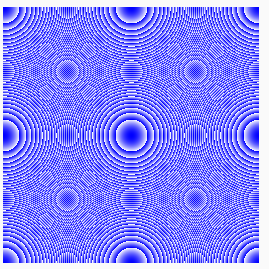
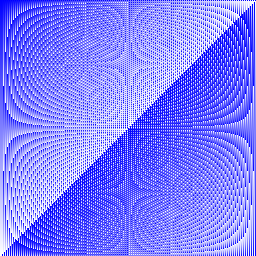
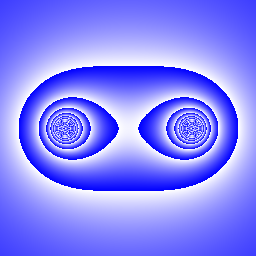
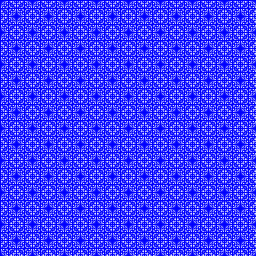


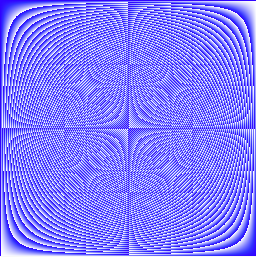
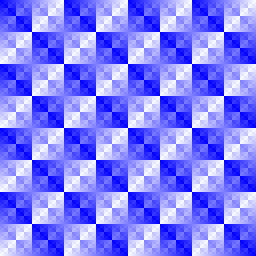
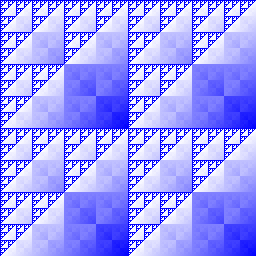
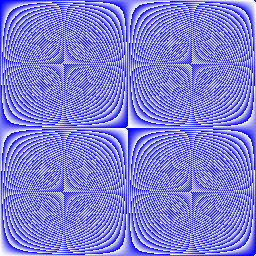
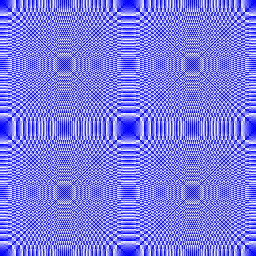
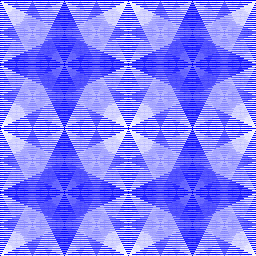
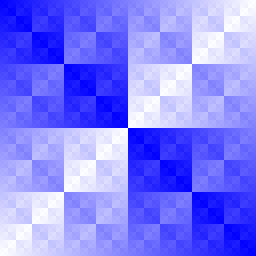

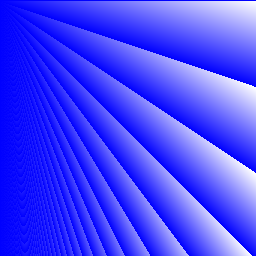
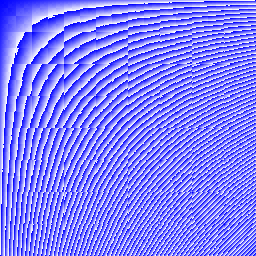
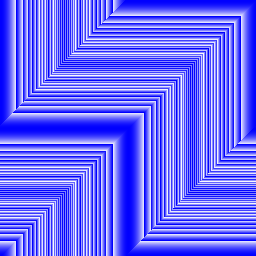
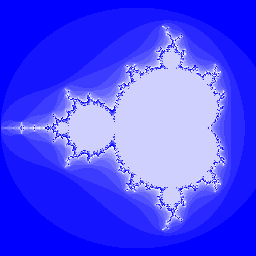
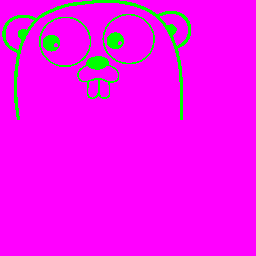
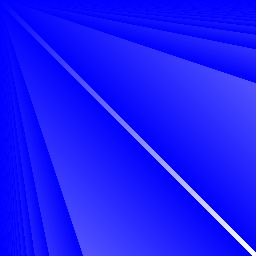
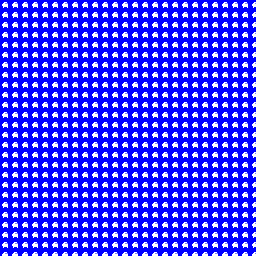




You guys are so creative